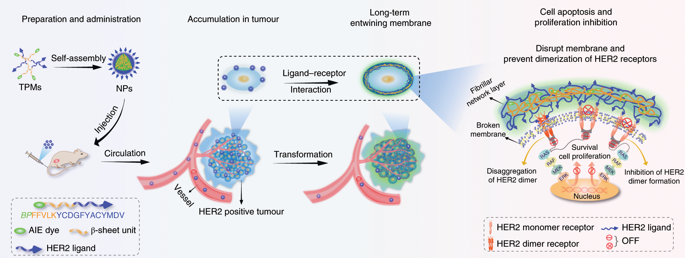Nature Nanotechnology ( IF 38.3 ) Pub Date : 2020-01-27 , DOI: 10.1038/s41565-019-0626-4 Lu Zhang 1 , Di Jing 1 , Nian Jiang 2, 3 , Tatu Rojalin 1 , Christopher M Baehr 1 , Dalin Zhang 1 , Wenwu Xiao 1 , Yi Wu 1 , Zhaoqing Cong 1 , Jian Jian Li 2 , Yuanpei Li 1 , Lei Wang 4 , Kit S Lam 1, 5

|
Human epidermal growth factor receptor 2 (HER2) is overexpressed in >20% of breast cancers. Dimerization of HER2 receptors leads to the activation of downstream signals enabling the proliferation and survival of malignant phenotypes. Owing to the high expression levels of HER2, combination therapies are currently required for the treatment of HER2+ breast cancer. Here, we designed non-toxic transformable peptides that self-assemble into micelles under aqueous conditions but, on binding to HER2 on cancer cells, transform into nanofibrils that disrupt HER2 dimerization and subsequent downstream signalling events leading to apoptosis of cancer cells. The phase transformation of peptides enables specific HER2 targeting, and inhibition of HER2 dimerization blocks the expression of proliferation and survival genes in the nucleus. We demonstrate, in mouse xenofraft models, that these transformable peptides can be used as a monotherapy in the treatment of HER2+ breast cancer.
中文翻译:

可转化肽纳米粒子在体内阻止 HER2 信号传导并导致癌细胞死亡
人表皮生长因子受体 2 (HER2) 在 > 20% 的乳腺癌中过度表达。HER2受体的二聚化导致下游信号的激活,使恶性表型能够增殖和存活。由于 HER2 的高表达水平,目前需要联合治疗来治疗 HER2 +乳腺癌。在这里,我们设计了无毒的可转化肽,它们在水性条件下自组装成胶束,但在与癌细胞上的 HER2 结合后,转化为纳米原纤维,破坏 HER2 二聚化和随后的下游信号传导事件,导致癌细胞凋亡。肽的相变能够实现特异性 HER2 靶向,抑制 HER2 二聚化会阻止细胞核中增殖和存活基因的表达。我们在小鼠异种移植模型中证明,这些可转化肽可用作治疗 HER2 +乳腺癌的单一疗法。



























 京公网安备 11010802027423号
京公网安备 11010802027423号